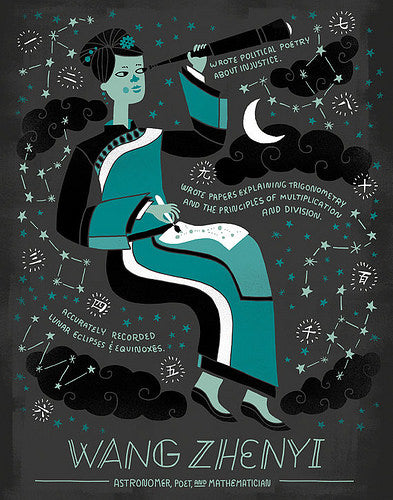
Move Over, Neil deGrasse Tyson: Meet 18th-Century Female Astronomer, Wang Zhenyi
Galileo. Carl Sagan. Neil deGrasse Tyson. Chances are you’ve heard of these famous star-gazers, but how about 18th-century Chinese female astronomer, Wang Zhenyi?
Astronomy in China has a long history, starting with oracle bones from the Chinese Bronze Age (c. 1600 to 1046 BC) etched with the movements of the moon to notable 4th-century BC astronomers Gan De and Shi Shen, believed to be the first in history to compile a star catalog.
Fast forward a few thousand years to the Qing Dynasty. Wang Zhenyi was born in 1768 into a family with a love for scholarship and study. Her grandfather, once governor of Fengchen county and Xuanhua District, had his own library. While her father failed the imperial exam, he made up for it by studying medicine on his own and recording his findings.
Several of Wang’s family members were directly involved in her education. Her father taught her medicine, geography, and mathematics. Her grandmother educated her about poetry while it was her grandfather who introduced her to astronomy. (It’s not clear what role her mother might have played.)
But her relatives weren’t her only teachers. She learned equestrian skills, archery, and martial arts from the wife of a Mongol general, and at 18 became friends with a group of female scholars. In the tradition of her father, she also educated herself, and even after marrying at 25, continued to learn and eventually became a teacher herself.
As an adult, she focused on poetry, mathematics, and of course astronomy. Her poetry explored the places and people she saw on travels with her father as well as the need for women’s roles to not be constrained to “cooking and sewing." Men and women “are all people,” she wrote, “who have the same reason for studying.”
In addition to 13 volumes of poetry, she wrote a book called The Simple Calculation Principles, a way to make learning math easier for beginners, and several articles on astronomy, such as "Dispute of Longitude and Stars" and “Dispute on the Precession of Equinoxes,” in which she described how equinoxes move and how to calculate their movements.
In “The Explanation of a Lunar Eclipse,” she analyzed the motions of the moon and described lunar and solar eclipses. Despite the work of astronomers like Zhang Heng and Shen Kuo, many still believed eclipses occurred because of angry gods or hungry dogs. In her article Wang reiterated, “Actually, it’s definitely because of the moon.” She demonstrated her hypothesis with an exhibit that showed how the passing of the moon (represented by a mirror) between the earth and the sun (a hanging lamp) caused an eclipse.
Sadly, Wang passed away from an unspecified illness at 29. However, she lives on her work, the tenacity showed to learn when educating women was frowned upon, and a crater on Venus named in her honor by the International Astronomical Union in 1994.
[Illustration by Rachel Ignotofsky via Women in Science: 50 Fearless Pioneers Who Changed the World. Used with permission and available for purchase.]
